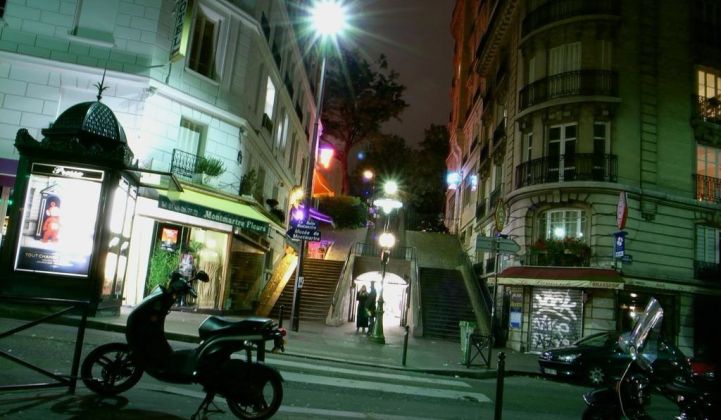Silver Spring Networks (SSNI), the smart grid networking company that wants to expand its reach to streetlights, traffic signals and other “smart city” devices, will get a chance to try it out in a city famous for its lights. The Redwood City, Calif.-based company said Thursday it's working with Paris lighting systems provider Evesa, in a small pilot that's part of a broader scheme to reduce the city's lighting energy consumption by nearly one-third by decade's end.
The pilot will focus on a small portion of a central Paris neighborhood along the Seine, Sterling Hughes, the Redwood City, Calif.-based company’s senior director of advanced technology, said in a phone interview. Silver Spring will be providing the unified wireless networking platform to link both street lights and traffic signals, primarily to drive better operational efficiency out of the system as a whole, he said.
While the terms and scope of the pilot aren’t yet defined, it’s part of the initial stages of what could grow to a pretty large citywide smart lighting and traffic project. Paris wants to reduce its overall lighting energy consumption by 30 percent from 2004 levels by 2020, through a combination of more efficient lighting like LEDs and smarter control systems. Reaching that goal without instituting unpopular lights-out regimes or changing the character of the city’s famous nightscapes will take some clever work.
This isn’t the only lighting technology project underway for Evesa, a consortium named after participating companies ETDE, Vinci Energies, SATELEC and Aximum that was formed in 2011 to carry out Paris’ ambitious lighting-efficiency project. Evesa has already been hard at work on revamping the lighting at famous Paris landmarks like the Place de la Concorde, and initial reports peg total project cost at between €500 million and €700 million ($650 million to $900 million). Silver Spring's new project is a tiny sliver of that amount, of course. (Financial details weren't disclosed.)
This particular project doesn’t involve replacing streetlights with LEDs or other more efficient light sources, he noted. Instead, it's aimed at networking what's there for increased operational efficiency, which can actually save more in street lighting costs than can energy efficiency gains. That’s because each networked street light or traffic signal can deliver useful information to operators, including whether they’re on or off, and of course, whether they’re working or not.
That may sound simple, but compared to today’s mostly "dumb" street lights, it’s a vast improvement, allowing cities or utilities to direct replacement crews to burned-out lights as they happen, instead of waiting for complaints or on-site inspections to discover the problem, to name one cost-saving measure. Silver Spring is enlisting the help of partner Streetlight.Vision, which makes streetlight monitoring and control software, for its Paris pilot, Hughes said.
Elsewhere, Silver Spring is also focusing on LED street lights for its push into city networking, he said. Last month it announced a partnership with LED Roadway Lighting, a Canadian company that makes LED replacement modules meant to fit into existing streetlight fixtures, for example. (LEDs are a natural fit for streetlights, since they last longer and run cheaper than their high-pressure sodium and metal halide predecessors, and offer a range of digital controls that lend themselves well to being networked.)
Beyond energy and operational savings, “there’s a whole spectrum of applications” for a network that uses ubiquitous traffic lights and light poles as its nodes, Hughes said. Silver Spring is working on projects with San Antonio, Texas municipal utility CPS Energy, as well as with partners in Singapore and Malaysia, that are aimed at expanding its wireless networks to more endpoints in a city, though details are as yet scarce.
In Paris, Silver Spring hasn’t yet picked any other specific features it will be working on with Evesa, Hughes said. Neither have the parties defined just what communications technologies they’ll use to get there, he said, though Silver Spring offers multiple networking technologies, including its RF mesh system, now used to network millions of smart meters around the world, and its newer cellular-compatible technology.
Silver Spring is far from the only company looking to streetlights as the logical node for citywide wireless networks, of course. San Jose, Calif.-based smart grid networking company Echelon has been connecting streetlights via the company’s powerline carrier (PLC) technology, now in use by lighting companies like Philips and Osram, and smart meter players like Sensus and ABB’s Tropos Networks have been adding streetlights to the list of devices they’re connecting in citywide wireless networks, to name a few competing examples.
At the same time, the market for smart streetlights is still tiny, with about half a million communications nodes shipped globally last year. However, Navigant’s Pike Research predicts the number of communications nodes to climb to 4.8 million by 2020, driven by rising energy prices and proof-of-concept deployments going on today proving out their worth.



